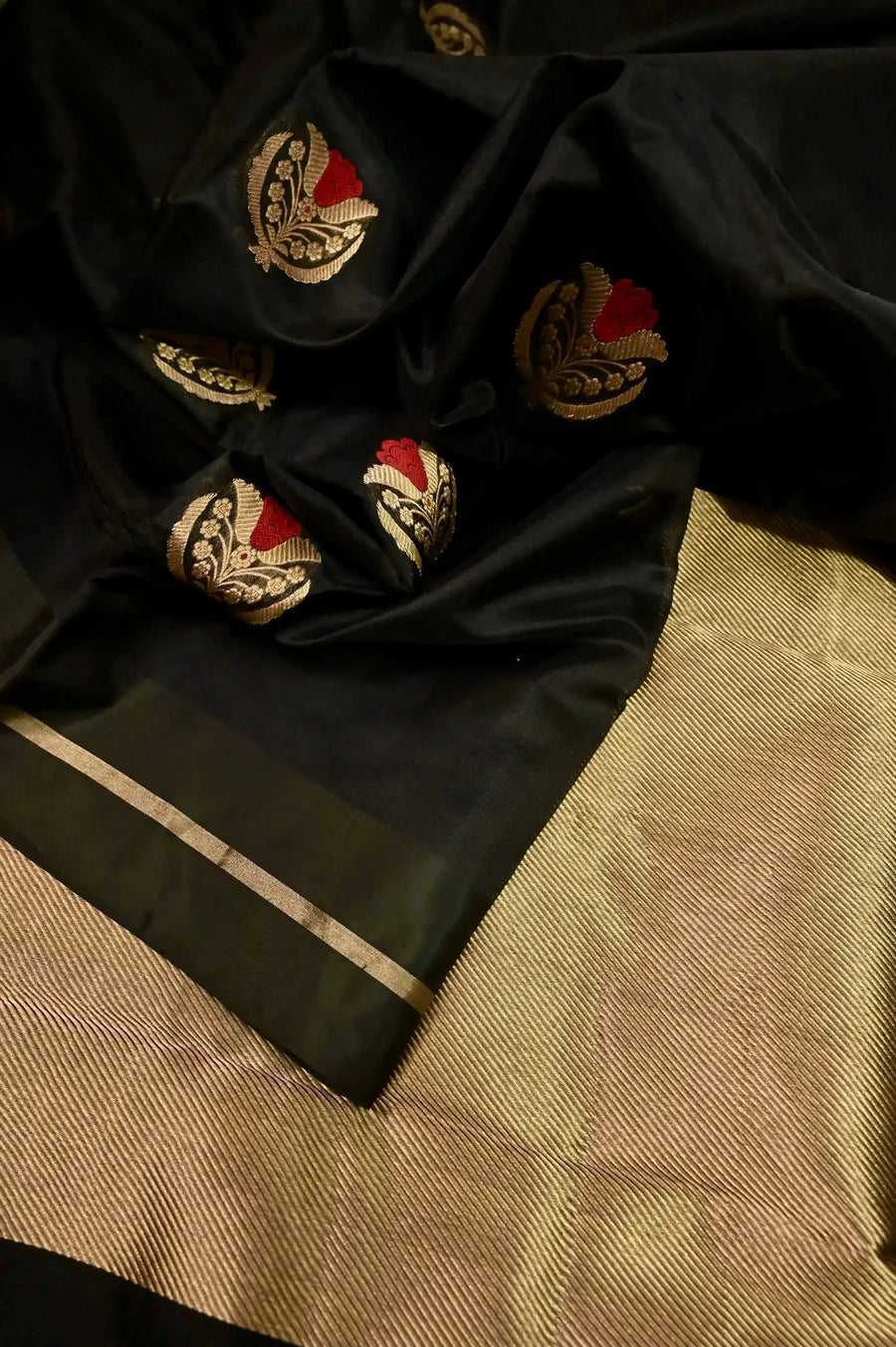Pure Chanderi Banarasi Silk Saree in Onyx Black Colo...
Chanderi Silk Sarees
To let you experience the sheer elegance of the fabric, here is IndyVogue with the Chanderi Silk Saree Collection! From classic designs in gold, silver, and beige shades to bold and vibrant hues like red, blue, and green, our collection has something for every style and personality. The intricate embroidery done on Chanderi silk saree with zari borders or pure Chanderi silk sarees with royal colors will surely be on your mind and cart too! Explore the various options now!
CHANDERI SAREE
Having originated from the town of Chanderi in Madhya Pradesh, the Chanderi saree is a lightweight garment known for its sheerness. It is made from a combination of silk, cotton and zari. Characterized by delicate motifs, it is a perfect wear for both festive occasions, as well as everyday life.
THE ORIGIN OF THE CHANDERI
The origin of the Chanderi saree can be traced back to about 2,000 years ago, during the rule of the Mauryan Empire. We can find mentions of it in ancient texts and inscriptions. The city of Chanderi was known for its rich craftsmanship. The art of weaving here gained prominence under the Marathas, and later the Mughals, who patronized it to a huge extent. In Kauatilya’s Arthashastra, we find mentions of the greatness of Chanderi in terms of weaving traditions. Around the 11th century, Chanderi became an important trade route for traders from Gujarat, Mewar and surrounding regions. Chanderi sarees, during this time, were woven mostly for the royalty.
A Sufi saint known as Hazrat Wajihuddin came to Chanderi around 1305 AD. It is commonly believed that a large number of the population of Bengal followed him to settle in Chanderi. It is also possible that these migrants started producing the fabric.
Interestingly, mentions of the Chanderi saree can also be found in Vedic texts, which attribute its origins to Shishupal, Krishna’s cousin.
Over the centuries, Chanderi sarees evolved from their early basic designs to more elaborate and intricate patterns. In the modern era, they are celebrated for their light, airy quality.
AN INTERESTING ENCOUNTER WITH AKBAR
A fascinating story regarding an encounter between the Mughal Emperor Akbar, and the weavers of Chanderi is a part of the town’s folklore and oral tradition. It is said that Akbar, who patronized the weavers and admired their arts, went to visit them to observe their handiwork from close quarters. He was gifted a piece of Chanderi as a token of appreciation from the weavers, and it is believed that Akbar was so taken aback by the delicate quality of the fabric, that he commented that it was made from air. Akbar also bestowed special honors on the weavers, and commissioned a large number of royal garments made of Chanderi, which were worn by his courtsmen. Although this story is not really well-documented in any particular historical text, it is an interesting part of Chanderi’s culture and tradition nonetheless.
While the authenticity of this ‘story’ might be debatable, it is a historical fact that Akbar was a huge admirer of art and culture, and he did, indeed patronize the Chanderi weavers. This was vouched for by historians like Abu’l Fazl, in his book Ain-i-Akbari.
GENERAL FACTS ABOUT THE CHANDERI SAREE
The weaving technique - Usually, Chanderi sarees are a blend of silk and cotton, and zari is used for the designs. The cotton helps the sarees remain lightweight. Traditional handlooms are used for the weaving, and the process involves interlacing the warp and the weft. The designs are hand-drawn, and put onto a jaala, which is a wooden instrument used to create patterns. The yarns are dyed separately, and natural dyes are used often to obtain pastel shades. A Chanderi saree can take up to 15 days to weave.
The motifs - Chanderi sarees have geometric motifs, such as triangles, diamonds and squares. The most common one, however, is the coin motif, or the ‘Ashrafi Butti’. The ‘Sada Suhagan’ is also a popular one, and it is given to new brides, as a blessing that they live long lives, but die before their husbands. Other marital motifs include the ‘Mehendi lagi haati’, and the palanquin motif. The peacock and the lotus are important symbols too.
The texture - The Chanderi saree is extremely lightweight. It is also sheer, which makes it almost transparent.
The separately woven design - The zari work in Chanderi sarees is done separately, and woven onto the main fabric.
Types of Chanderi sarees - Chanderi sarees can be of 3 types: Silk cotton, pure silk, and Chanderi cotton.
The Chanderi Saree in Modern Times
In recent years, like every other traditional attire, the Chanderi saree has been experimented with by fashion designers, and many celebs, including our favorite Bollywood actresses, have chosen it for various award shows, film promotions, etc.
Sabyasachi Mukherjee has incorporated the Chanderi saree in many of his collections, as have others, like Anita Dongre, and Manish Malhotra.
Deepika Padukone’s iconic Chanderi look - Deepika Padukone was seen wearing a glamorous white Chanderi designed by Sabyasachi at her ‘Padmavat’ promotions. The actress had decided to pair it with a simple ponytail, and a heavy necklace, along with jhumkas.
Kareena Kapoor Khan’s love for the Chanderi - Kareena Kapoor Khan has been spotted donning the Chanderi, with designs from Anita Dongre, many times. One iconic look was that of her wearing a black Chanderi, with a black, half-sleeved blouse. The cele had decided to keep the look simple enough, wearing her hair down and pairing it with minimal jewelry and makeup.
Vidya Balan and her gorgeous traditional attires - Vidya Balan is known for her love for ethnic attire, especially sarees. The icon has worn the Chanderi saree at many award shows as well as interviews, with the garments revealing her sophisticated style. For the promotion of her movie ‘Sherni’, she chose an ivory Chanderi saree, with a thick maroon border. The saree featured little elephant prints, and Vidya Balan accentuated her already elegant look with a striped blouse and glossy, red lipstick.
Alia Bhatt’s iconic Chanderi look for her ‘Gangubai’ promotions - During the promotion of ‘Gangubai Kathiawadi’, Alia Bhatt, wore a series of gorgeous sarees. One that stood out in particular, was, of course, a beautiful white Chanderi saree, with a golden border, and minimalist yellow floral prints. The celeb wore her hair down, and finished the look with a white blouse, a pair of jhumkas, and a simple bindi.
WHEN AND HOW YOU SHOULD WEAR THE CHANDERI SAREE
Summer festivities - Since the Chanderi saree is an extremely lightweight garment, it is perfect for summer weddings or festivals. The sheer fabric helps you breathe better, and helps cope with the heat. Bright colors, such as orange, and pastel shades, such as light pink or light yellow, are perfect for an event being held during the daytime. You can match it with a blouse of a deeper shade, and wear your hair down to get the perfect summertime look!
Weddings - Got an important wedding event coming up within the summer months? Opt for the classic Chanderi! The exquisite zari work will only add to your shimmer, and you’ll stand out! Bright, festive colors, like deep green or maroon is the way to go, and diamond or gold chokers, paired with a stylish bun, will complete the perfect look!
Parties - If you’re looking for a Chanderi saree to wear at a formal party, or a family gathering, you can never really go wrong with a rose gold, or light blue one. Throw some light jewelry, such as hoop earrings, into the mix, and you’re good to go!
Everyday wear - Since the Chanderi saree is so easy to drape, and the cotton is so light and breathable, you can wear it on a daily basis as well. It’s a stylish, yet comfy choice.
HOW TO TAKE CARE OF A CHANDERI SAREE
Taking proper, and regular care of your Chanderi saree is very important, because you don’t want to ruin the delicate, exquisite zari work. So, here are some DOs and DON’Ts:
Dry clean - Your Chanderi saree should be preferably dry cleaned. Otherwise, it might be damaged and the intricate work can be ruined.
Storage - Remember to store your Chanderi saree in a dry, cool place, devoid of much moisture. Use a cover to protect it from dust. This cover should preferably be a cloth and not a plastic one, because plastic can trap moisture and ruin the fabric.
Avoid excessive exposure to the sunlight - Exposure to the sun for elongated periods of time can cause the designs on your Chanderi to fade, and also weaken the fabric.
Use mild chemicals - If you’re planning to wash your Chanderi by hand, make sure to not use any sort of strong detergent or chemical. This will affect both the fabric and the color. Instead, wash your Chaderi saree in cold water, using a mild detergent.
Things to keep in mind while shopping for Chanderi sarees online:
The fabric - Chanderi sarees are known for their lightweightness and sheerness, and this sheer fabric is combined with cotton. So make sure to check the fabric composition from the description to ensure authenticity.
Authenticity - Make sure that you purchase your Chanderi saree from authentic sites or retailers, so that your saree is original. Shop Chanderi Sarees online at IndyVogue.
The colors - Often, colors of an item we are buying online turn out to be different than what appeared on screen. Make sure to verify first.
Return policy - Read the terms and conditions, especially with regard to the return policy, before placing your order. This way, you can always have the option of returning your saree and getting a refund if it is not up to your expectation.
Care instructions - The Chanderi saree is an extremely delicate piece. Proper care to ensure longevity is essential. So, do read up on how to care for your saree before purchasing it first.
Customer reviews - Read the reviews of customers who have purchased the product before you, to get a fair idea of the quality, customer service, etc. IndyVogue has over 700+ verified customer reviews on Google and Facebook.
Explore Our Collection
Suits & Dresses
Festive Wear Salwar Suits USA |
Collections By Type
Art Silk Sarees | Baluchari Silk Sarees | Banarasi Silk Saree | Bengal Cotton | Bishnupuri Silk Sarees | Chanderi Silk Sarees | Crepe Silk Sarees | Dupion Silk Sarees | Embroidery Sarees | Gadwal Silk Sarees | Georgette Silk Sarees | Ikat Silk Saree | Jamdani Saree | Kanchipuram / Kanjeevaram Silk Saree | Kani Silk Saree | Latest Saree Collection | Linen | Matka Silk Sarees | Paithani Saree in USA | Pure Organza Silk Sarees | Pure Silk Sarees | Raw Silk Sarees | Sale | Sambalpuri Silk Sarees | Tissue Sarees | Tussar Silk Saree |
Collections By Work
Bandhani Sarees | Hand Embroidery Sarees USA - Kantha Stitch Saree | Hand Painted Sarees | Kalamkari Sarees | Machine Embroidery Sarees | Printed Sarees | Sequin Sarees Collection |
Collections By Region
From the East | North Indian Sarees | Sarees of Central India | South Indian Silk Sarees | West Indian Saree |Collections By Occasion
Baisakhi Collection | Bollywood Sarees | Casual Wear Sarees | Cocktail Sarees | Festival Collection Saree | Party Wear Sarees | Saraswati Puja Collection | Valentine's Day Collection | Wedding Collection Saree |
Collections By Color
Black Saree Collection | Blue Sarees Collection | Golden Sarees Collection | Green Sarees Collection | Maroon Sarees Collection | Orange Sarees Collection | Pink Sarees Collection | Purple Sarees Collection | Red and White Saree Collection | Red Sarees Collection | White Sarees Collection | Yellow Sarees |
Collections By Price
Under $100 USD | Under $150 USD | Under $200 USD | Under $300 USD | Under $400 USD | Under $500 USD |
Special Collections
Double Savings Collection | Silk Mark Certified Saree | The Kolkata Collection |
Accessory Collections
Designer Blouse Online | Indian Fashion Jewellery | Trendy Designer Bags |






















